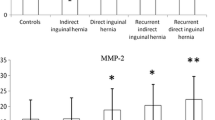Abstract
Background
The development of inguinal hernia might be related with collagen metabolism, which was regulated by matrix metalloproteinases (MMPs) and tissue inhibitors of metalloproteinases (TIMPs). The aim of this study was to evaluate the mRNA and protein expression levels of MMP-2 and TIMP-2 in anterior rectus sheath fascia to investigate the function of them in inguinal hernia formation.
Methods
The study enrolled 48 primary inguinal hernia patients: 32 participants had indirect inguinal hernia and 16 patients suffered direct inguinal hernia. Specimens were taken from the anterior rectus sheath fascia. The amounts of MMP-2 mRNA and TIMP-2 mRNA were evaluated by real-time fluorescence quantitative polymerase chain reaction (RT-PCR), and immunohistochemistry was performed to assess the protein expression of them.
Results
The mRNA and protein expression levels of MMP-2 in direct group were significantly higher than those of control group (P < 0.05) and indirect group (P < 0.05), while the expression levels of TIMP-2 in direct group were significantly lower than those of control group (P < 0.05) and indirect group (P < 0.05). The ratio of MMP-2 mRNA/TIMP-2 mRNA in direct group was significantly higher than that of control group (P < 0.05) and indirect group (P < 0.05), and the ratio of indirect group was significantly higher than that of control group (P < 0.05). According to receiver operating characteristic (ROC) curve, MMP-2/TIMP-2 can diagnose direct hernia from controls with area under the curve (AUC) of 0.950 and indirect hernia with AUC of 0.730 effectively.
Conclusions
Elevated level of MMP-2 and decreased level of TIMP-2 may play a role in direct inguinal hernia development. The ratio of MMP-2/TIMP-2 may be useful in identification of direct hernia.




Similar content being viewed by others
References
Kingsworth A, Leblanc K (2003) Hernias:inguinal and incisional. Lancet 362:1561–1571
Wang D, Chen J, Chen Y et al (2018) Prospective analysis of epigastric, umbilical, and small incisional hernia repair using the modified Kugel oval patch. Am Surg 84:305–308
Burcharth J, Pommergaard HC, Rosenberg J (2013) The inheritance of groin hernia: a systematic review. Hernia 17:183–189
Zöller B, Ji J, Sundquist J et al (2013) Shared and nonshared familial susceptibility to surgically treated inguinal hernia, femoral hernia, incisional hernia, epigastric hernia, and umbilical hernia. J Am Coll Surg 217:289–299
Henriksen NA, Yadete DH, Sorensen LT et al (2011) Connective tissue alteration in abdominal wall hernia. Br J Surg 98:210–219
Antoniou SA, Antoniou GA, Granderath FA et al (2009) The role of matrix metalloproteinases in the pathogenesis of abdominal wall hernias. Eur J Clin Invest 39:953–959
Nagase H, Visse R, Murphy G (2006) Structure and function of matrix metalloproteinases and TIMPs. Cardiovasc Res 69:562–573
Isik A, Gursul C, Peker K et al (2017) Metalloproteinases and their inhibitors in patients with inguinal hernia. World J Surg 41:1259–1266. https://doi.org/10.1007/s00268-016-3858-6
Antoniou GA, Tentes IK, Antoniou SA et al (2011) Matrix metalloproteinase imbalance in inguinal hernia formation. J Invest Surg 24:145–150
Gu X, Guo XK, Chen BH et al (2019) Prognostic and clinicopathological value of ZIC1 in patients with cervical squamous cell carcinoma. Oncol Lett 18:6621–6627
Flum DR, Fisher N, Thompson J et al (2005) Washington state's approach to variability in surgical processes/outcomes: Surgical Clinical Outcomes Assessment Program (SCOAP). Surgery 138:821–828
Zheng H, Si Z, Kasperk R et al (2002) Recurrent inguinal hernia: disease of the collagen matrix? World J Surg 26:401–408
Visse R, Nagase H (2003) Matrix metalloproteinases and tissue inhibitors of metalloproteinases: structure, function, and biochemistry. Circ Res 92:827–839
Brew K, Nagase H (2010) The tissue inhibitors of metalloproteinases (TIMPs): an ancient family with structural and functional diversity. Biochim Biophys Acta 1803:55–71
Pascual G, Rodríguez M, Gómez-Gil V et al (2010) Active matrix metalloproteinase-2 upregulation in the abdominal skin of patients with direct inguinal hernia. Eur J Clin Invest 40:1113–1121
Peeters E, De Hertogh G, Junge K et al (2014) Skin as marker for collagen type I/III ratio in abdominal wall fascia. Hernia 18:519–525
Szczesny W, Cerkaska K, Tretyn A et al (2006) Etiology of inguinal hernia: ultrastructure of rectus sheath revisited. Hernia 10:266–271
Aren A, Gökçe AH, Gökçe FS et al (2011) Roles of matrix metalloproteinases in the etiology of inguinal hernia. Hernia 15:667–671
Henriksen NA, Sørensen LT, Jorgensen LN et al (2013) Circulating levels of matrix metalloproteinases and tissue inhibitors of metalloproteinases in patients with incisional hernia. Wound Repair Regen 21:661–666
Sørensen LT (2006) Effect of lifestyle, gender and age on collagen formation and degradation. Hernia 10:456–461
Ren J, Yang M, Xu F et al (2019) Acceleration of wound healing activity with syringic acid in streptozotocin induced diabetic rats. Life Sci 233:116728
Whiteford L (2003) Nicotine, CO and HCN: the detrimental effects of smoking on wound healing. Br J Community Nurs 8:22–26
Barnett C, Langer JC, Hinek A et al (2009) Looking past the lump: genetic aspects of inguinal hernia in children. J Pediatr Surg 44:1423–1431
Zhang Y, Han Q, Fan H et al (2014) Genetic analysis of the TBX2 gene promoter in indirect inguinal hernia. Hernia 18:513–517
Lau H, Fang C, Yuen WK et al (2007) Risk factors for inguinal hernia in adult males: a case-control study. Surgery 141:262–266
Jansen PL, Klinge U, Jansen M et al (2009) Risk factors for early recurrence after inguinal hernia repair. BMC Surg 9:18
Acknowledgements
The study was funded by Scientific and Technological Development Project of Henan Province in 2017 (Number: 172102310274).
Author information
Authors and Affiliations
Corresponding author
Ethics declarations
Conflict of interest
The authors declare that they have no conflict of interest.
Additional information
Publisher's Note
Springer Nature remains neutral with regard to jurisdictional claims in published maps and institutional affiliations.
Rights and permissions
About this article
Cite this article
Wang, D., Han, Y., Xu, X. et al. Matrix Metalloproteinases (MMP-2) and Tissue Inhibitors of Metalloproteinases (TIMP-2) in Patients with Inguinal Hernias. World J Surg 44, 3679–3686 (2020). https://doi.org/10.1007/s00268-020-05674-0
Published:
Issue Date:
DOI: https://doi.org/10.1007/s00268-020-05674-0




